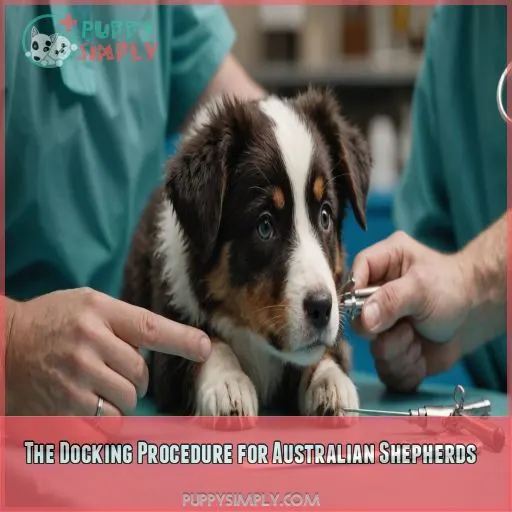This site is supported by our readers. We may earn a commission, at no cost to you, if you purchase through links.
 You’re considering tail docking for your Australian Shepherd for cosmetic reasons?
You’re considering tail docking for your Australian Shepherd for cosmetic reasons?
Well, let’s get real – it’s a pretty contentious topic.
The American Veterinary Medical Association is against it, and for good reason: it’s super painful for dogs.
In fact, many vets now recommend removing tail docking from breed standards altogether.
But what’s behind this trendy practice, and is it really worth it?
As you weigh the pros and cons, you might be surprised to learn that naturally bobbed Aussies are just as healthy and happy as their docked counterparts.
Want to know the whole story?
Table Of Contents
- Key Takeaways
- History of Australian Shepherd Tail Docking
- The Docking Procedure for Australian Shepherds
- Controversy Surrounding Cosmetic Tail Docking
- Impact on Australian Shepherd Health and Behavior
- Alternatives to Cosmetic Tail Docking
- Frequently Asked Questions (FAQs)
- Why were Australian Shepherds tails docked?
- Why do they dock dogs tail for medical reasons?
- Can Australian Shepherds have naturally docked tails?
- Does tail docking hurt dogs?
- Are Australian Shepherds born with naturally short tails ?
- Can I dock my Australian Shepherds tail at any age?
- Is tail docking a requirement for Australian Shepherd breeding ?
- Does tail docking affect an Australian Shepherds balance and movement ?
- Are there countries where tail docking for Australian Shepherds is banned ?
- Conclusion
Key Takeaways
- Consider the pain and potential risks of tail docking, and weigh the pros and cons before making a decision.
- Learn about the history and evolution of tail docking, and how it remains a contentious issue today.
- Understand that Australian Shepherds can be naturally bobbed or have naturally docked tails, and that there is no significant difference in health, temperament, or working ability between the two.
- Prioritize your dog’s well-being and consider alternatives to cosmetic tail docking, such as breeding for natural bobtails or leaving tails intact, to promote a more inclusive and ethical approach to dog breeding.
History of Australian Shepherd Tail Docking
You might be surprised to learn that tail docking in Australian Shepherds has a long and controversial history. Let’s explore how this practice began, how it’s evolved over time, and why it’s still a hot topic in the dog breeding world today.
Origins of the Practice
You might be surprised to learn that Australian Shepherd tail docking has roots in rural traditions. Back in the day, these pups were working dogs on farms. Folks believed docking prevented injuries and kept them nimble. It’s like giving your furry friend a practical haircut – only more controversial! Let’s dig into this tail-wagging tale.
Breed Standards and Cosmetic Preferences
You might be shocked to learn about the breed standards shaping Australian Shepherd tail docking. It’s not just about looks—it’s a complex issue. Here’s what drives this practice:
- Show ring expectations
- Owner preferences for a "clean" look
- Historical beliefs about working dogs
Ready to dig deeper into this hot-button topic?
Evolution of Docking Practices Over Time
Over time, tail docking practices have shifted dramatically. You’ll find breed standards changing, with legal restrictions popping up left and right. Ethical concerns have sparked heated debates, and cultural shifts are reshaping our views. Veterinarians are now leading the charge against unnecessary docking. It’s a whole new ball game when it comes to dog tails!
Cultural and Regional Variations in Docking
You’ll find that docking laws and breed standards aren’t set in stone worldwide. Regional preferences play a big role in how Aussies’ tails are treated. Some countries have banned the practice, while others still embrace it. It’s like a global patchwork quilt of cultural acceptance – no two pieces are exactly alike!
The Docking Procedure for Australian Shepherds
You might think tail docking is no big deal, but the procedure for Australian Shepherds is more complex than you’d expect. Let’s uncover the nitty-gritty details of this trendy practice, from timing to potential risks, so you can make an informed decision for your furry friend.
Timing of the Procedure
- Ideal age: 2-5 days old
- Legal limits vary by location
- Pain Management is really important
- Healing time: 1-2 weeks
- Complications risk increases with age
Methods Used for Tail Docking
You might be surprised to learn that tail docking isn’t just a snip-snip affair. Vets use surgical tools to remove part of your Aussie’s tail, typically within days of birth. It’s a quick procedure, but healing takes time and there are risks involved.
Anesthesia and Pain Management Considerations
You might be wondering about pain management during docking. Sadly, it’s often done without anesthesia. Some vets use local numbing, but it’s not foolproof. Long-term pain is a real concern. It’s like pulling off a Band-Aid, but way worse.
Potential Risks and Complications
You might think tail docking is a walk in the park, but it’s no picnic. Here are some potential risks that’ll make your tail spin:
- Infection: Your pup’s new ‘do could become a breeding ground for bacteria.
- Hemorrhage: Bleeding’s no joke—it can turn serious fast.
- Nerve damage: Ouch! This could lead to long-term pain.
- Deformity: Sometimes, things don’t heal quite right.
Post-procedure Care and Healing Process
After docking, your Aussie’s recovery is super important. Here’s a quick guide to post-procedure care:
| Phase | Focus | Duration |
|---|---|---|
| Early | Wound care, pain management | 1-3 days |
| Mid | Infection prevention, limited activity | 4-7 days |
| Late | Healing completion, gradual return to normal | 1-2 weeks |
Controversy Surrounding Cosmetic Tail Docking
You might be surprised to learn that tail docking in Australian Shepherds isn’t just a harmless trend. This practice has sparked heated debates about animal welfare, with passionate arguments on both sides and varying legal standings around the world.
Ethical Concerns and Animal Welfare Debates
You’re faced with a real head-scratcher when it comes to tail docking. It’s not just about looks – there are serious ethical concerns to chew on. Animal welfare advocates argue it’s painful and unnecessary, while breed enthusiasts claim it’s part of tradition. What’s your take?
Arguments for and Against the Practice
You’ve probably heard arguments both for and against tail docking in Aussies. Let’s break down the key points:
- "It’s tradition!" vs. "Times have changed."
- "Prevents injuries" vs. "Tails serve a purpose."
- "Meets breed standards" vs. "Standards can evolve."
- "Painless when young" vs. "Unnecessary surgery.
Legal Status and Regulations in Different Countries
You’ll find tail docking laws vary widely across the globe. While the EU’s banned it, the US is a mixed bag. Canada’s cracking down, and Australia’s on the fence. It’s a legal minefield, so best to check your local rules before deciding!
Veterinary Perspectives on Cosmetic Docking
Veterinarians are increasingly voicing concerns about cosmetic tail docking. They’re caught between breed standards and ethical considerations. As a pet parent, you’ll find many vets now advocating for alternatives. Here’s what they’re saying:
- Pain management is super important
- Client education is key
- Breed standards need updating
Public Opinion and Changing Attitudes
You’re part of the shift in public opinion on tail docking for cosmetic reasons. Social media’s sparked conversations, and veterinarians are speaking out. As an Australian Shepherd owner, you need to think about the ethics and breed standard changes.
Impact on Australian Shepherd Health and Behavior
You’re probably wondering how tail docking affects your Australian Shepherd’s overall health and behavior – after all, it’s a pretty significant change to their body. Let’s take a closer look at the physical effects, behavioral implications, and long-term health consequences of tail docking, as well as how it compares to naturally bobbed Aussies (Source).
Physical Effects of Tail Docking
You’re about to discover the physical effects of tail docking on your Australian Shepherd. Here are three things to keep in mind:
- Balance changes: A shorter tail can affect your dog’s balance and movement.
- Muscle development: Docking can impact the muscles in your dog’s back and hind legs.
- Gait impact: Your dog’s gait may change, potentially leading to long-term joint issues.
Behavioral Implications of Tail Removal
When your Australian Shepherd’s tail is docked, it can affect their behavior. They may struggle with anxiety, aggression, and training challenges. Let’s break it down:
| Breed | Behavioral Implication | Risk Level |
|---|---|---|
| Australian Shepherd | Increased anxiety | High |
| Doberman Pinscher | Aggression | Medium |
| All breeds | Training challenges | Low |
| All breeds | Reduced "happy tail" wagging | Medium |
| Australian Shepherd | Compensatory behaviors | High |
Communication and Social Interaction Changes
As your Australian Shepherd adjusts to life without its tail, you’ll notice subtle changes in its communication style. Body language changes, vocalization differences, and tail-wagging cues may be altered, impacting your connection and social interactions.
Potential Long-term Health Consequences
When thinking about tail docking for your Australian Shepherd, it’s important to think about the potential long-term health effects. Here are some possible risks to keep in mind:
- Increased risk of pain and discomfort
- Higher likelihood of infection
- Potential for nerve damage
Comparison With Naturally Bobbed Aussies
You’re probably wondering how naturally bobbed Aussies compare to docked ones.
Research suggests there’s little difference in health, temperament, or working ability between naturally bobbed and docked Aussies.
Some owners note temperament variations, but research shows no significant health differences.
The American Kennel Club still recognizes both varieties, while groups like PETA advocate for an end to cosmetic docking.
While selective breeding for naturally bobbed Aussies raises concerns among some groups, research shows little difference in health, temperament, and working ability.
The American Kennel Club still upholds breed standards, while organizations like PETA advocate for a more natural approach to tail length.
Alternatives to Cosmetic Tail Docking
You’re considering alternatives to cosmetic tail docking for your Australian Shepherd, and that’s a great step in supporting their welfare. Now, let’s explore some options, such as breeding for natural bobtails, leaving tails intact, and changing breed standards, that can help you make an informed decision that’s best for your furry friend.
Breeding for Natural Bobtails
Let’s talk about breeding for natural bobtails as a way to avoid tail docking. Here are some key points to keep in mind:
- Researching bobtail genetics to understand how the trait is passed down
- Developing breeding programs that put natural bobtails first
- Keeping an eye on bobtail frequency to make sure there’s a healthy mix of genes
- Focusing on ethical breeding practices that put dog welfare before looks
Leaving Tails Intact and Changing Breed Standards
Let’s talk about changing breed standards. By leaving tails intact, we’re promoting a more natural, healthier look for Australian Shepherds. It’s time to rethink the status quo and prioritize our dogs’ well-being over aesthetics.
| Benefits of Intact Tails | Impact on Breed Standards |
|---|---|
| Promotes natural look | Challenges traditional breed standards |
| Reduces risk of complications | Encourages owner education on tail care |
| Preserves tail functionality | Fosters a more inclusive dog show environment |
| Aligns with ethical considerations | Supports the evolution of breed standards |
| Prioritizes dog welfare | Recognizes the importance of tail integrity |
Non-surgical Alternatives for Appearance Modification
Considering non-surgical alternatives for appearance modification? You can try tail wraps or creative hair styling to achieve a breed-standard look without the surgery. These options allow you to conform to breed standards while also considering ethical implications.
Education and Awareness Campaigns
You can join the movement to end cosmetic tail docking by spreading awareness and supporting education campaigns. Partner with vets, breeders, and owners to promote tail docking ethics, and together, let’s redefine breed standards that prioritize animal welfare.
Focusing on Other Breed Characteristics
You can shift your focus to other amazing breed characteristics, like their intelligence, agility, or stunning coat colors. Here are a few:
- Aussies’ intelligence: They’re highly trainable and thrive on mental stimulation.
- Working dog abilities: Bred to herd, they excel in dog sports like agility and obedience.
- Coat color variations: With a range of colors, you can appreciate their unique beauty without tail docking.
Frequently Asked Questions (FAQs)
Why were Australian Shepherds tails docked?
Historically, about 70% of certain breeds had their tails docked. You might wonder, why were their tails docked? Well, their tails were often docked to conform to breed standards, a practice that’s now increasingly debated.
Why do they dock dogs tail for medical reasons?
You’re wondering why dogs’ tails are docked for medical reasons? Well, it’s usually to prevent further injury or infection from trauma, "happy tail" syndrome, or certain medical conditions, and your veterinarian will guide you on the best course of action . You may need to dock your dog’s tail for medical reasons if they’ve experienced trauma, injury, or conditions like "happy tail" syndrome, where excessive wagging leads to repeated injuries . You might be wondering, why do vets dock a dog’s tail for medical reasons? Well, it’s usually due to trauma, injury, or conditionsYou like "Happy Tail" Syndrome, where’re excessive wondering wag whyging dogs leads’ to tails repeated are docked for medical reasons? Well, injuries it [‘scitation:2][citation:5 usually]. to prevent further injury or infection from conditions like "Happy Tail" syndrome, where excessive wagging leads to repeated trauma .
Can Australian Shepherds have naturally docked tails?
You might’ve heard that some dogs are born with naturally short or docked tails. It’s not common, but it’s estimated that about 1 in 20,000 puppies are born with natural bobbed tails. So, can Australian Shepherds fall into this category? The answer is yes.
Does tail docking hurt dogs?
When done early, tail docking is considered less painful for dogs, but it’s still a surgical procedure that carries risks. Your veterinarian will help you weigh the pros and cons to make an informed decision.
Are Australian Shepherds born with naturally short tails ?
No, Australian Shepherds aren’t born with naturally short tails. Like many breeds, they’re often docked for cosmetic or historical reasons. But, some Aussies do have a natural bobtail due to a genetic mutation.
Can I dock my Australian Shepherds tail at any age?
Don’t cry over spilt milk, but do consider the timing. Tail docking is typically done within the first 5 days of life. After that, it’s a more complex procedure requiring anesthesia, and risks increase with age.
Is tail docking a requirement for Australian Shepherd breeding ?
You might wonder if tail docking is a must-do when breeding Australian Shepherds. Well, it’s not a requirement. This decision’s up to you, but it’s best to weigh the pros and cons first.
Does tail docking affect an Australian Shepherds balance and movement ?
You bet your bottom dollar that a dog’s tail plays a huge role in how they move and balance. Take a look at a dog trying to navigate a tricky obstacle course with a wagging tail — it’s like a built-in rudder!
Are there countries where tail docking for Australian Shepherds is banned ?
Yes, certain countries have banned cosmetic tail docking due to ethical concerns. The UK, for example, prohibits docking unless it’s for therapeutic or acceptable prophylactic reasons. The US, however, leaves it as a personal choice.
Conclusion
It’s time to stop the debate surrounding Australian Shepherd tail docking for cosmetic reasons.
Naturally bobbed Aussies are just as healthy and happy as their docked counterparts.
By choosing to leave tails intact, you’re prioritizing your dog’s well-being and embracing the unique charm of this beloved breed.
Focus on what truly matters – your furry friend’s happiness.











